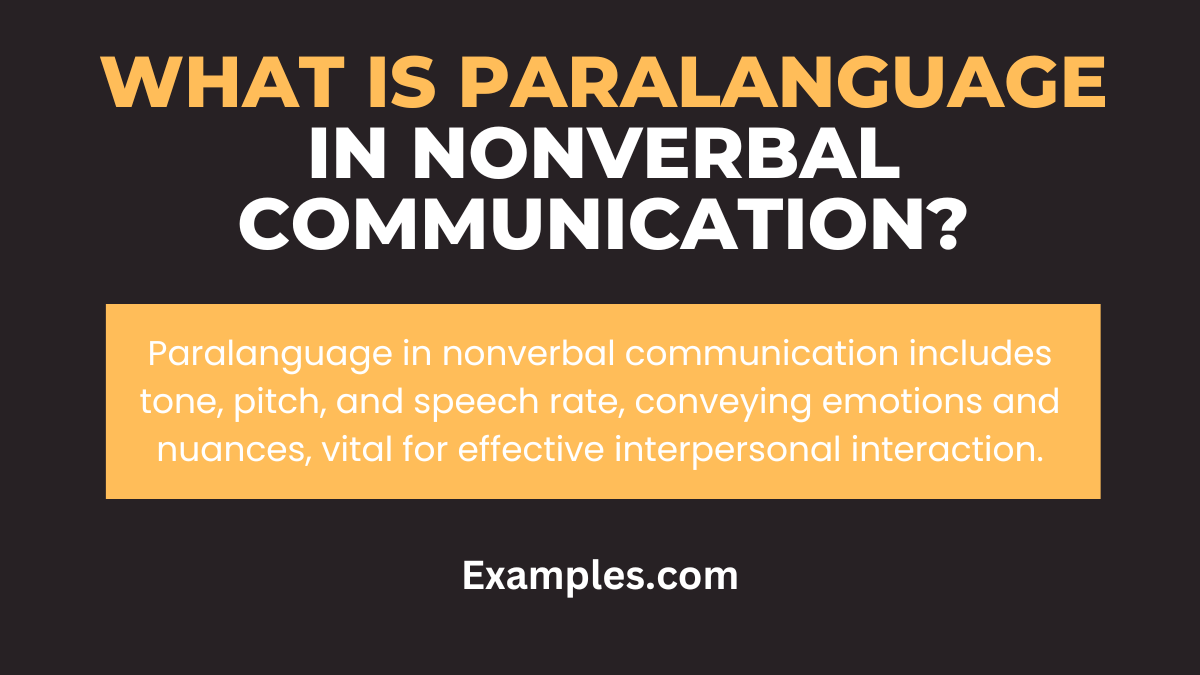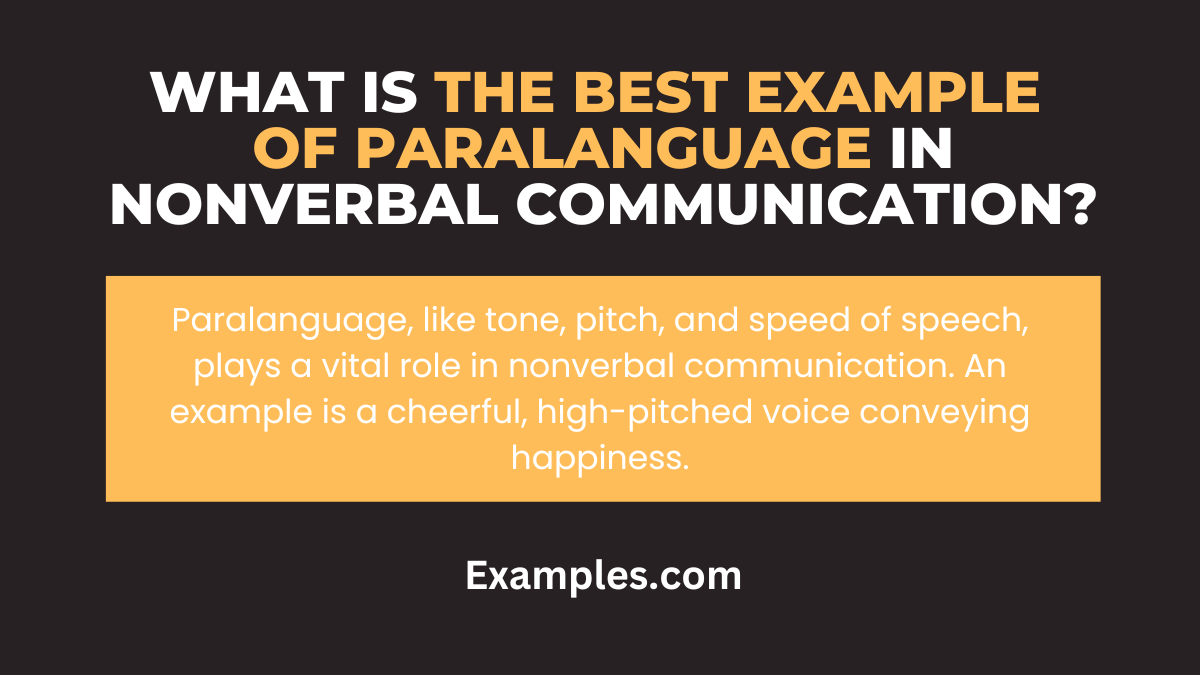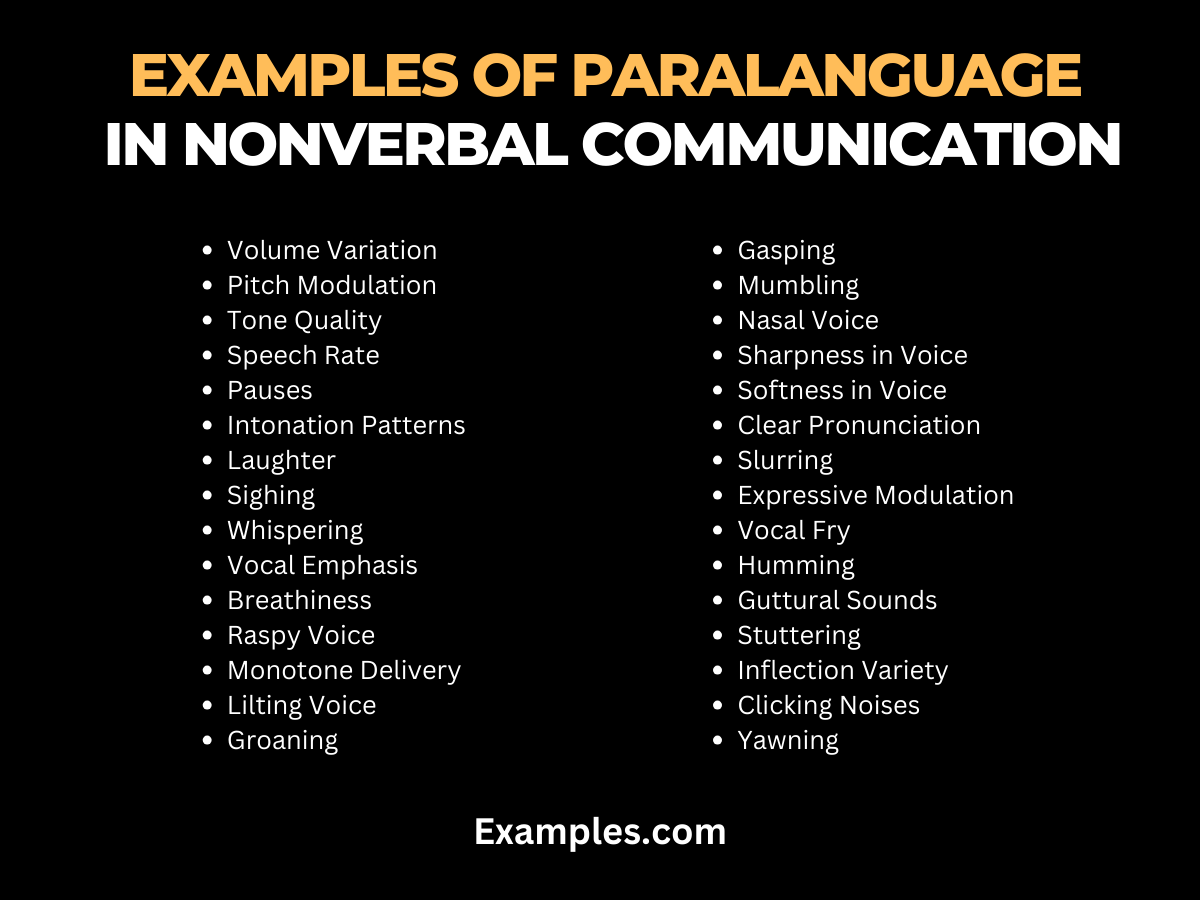29+ Paralanguage (Vocalics) in Nonverbal Communication Examples
Discover the intriguing world of Paralanguage in Nonverbal Communication through this comprehensive guide. Paralanguage, a critical aspect of nonverbal cues, involves understanding how tone, pitch, and silence impact communication. By mastering paralanguage, you can enhance your ability to convey and interpret messages beyond words. This guide will provide you with practical examples and essential insights, helping you to navigate the subtle yet powerful realm of nonverbal communication.
What is Paralanguage in Nonverbal Communication?

Paralanguage in Nonverbal Communication refers to the non-lexical components of speech, such as tone, pitch, volume, and speaking rate, that convey meaning and emotion. Unlike verbal communication, which relies on words, paralanguage communicates feelings and attitudes without using spoken language. Understanding paralanguage is crucial in interpreting the full message conveyed in interpersonal interactions.
What is the Best Example of Paralanguage in Nonverbal Communication?

A quintessential example of paralanguage in nonverbal communication is the tone of voice. For instance, a soft, gentle tone can indicate kindness or empathy, while a sharp, rapid tone might signal anger or impatience. Paralanguage also includes pauses and silence, which can be powerful in conveying thoughtfulness or hesitation. Understanding these subtle cues is essential for effective communication and can greatly impact the interpretation of a message.
30 Examples of Paralanguage in Nonverbal Communication

Paralanguage, a key component of nonverbal communication, encompasses the vocal cues that accompany spoken language, significantly influencing communication effectiveness. This guide explores 30 unique characteristics of paralanguage in nonverbal communication, providing insights into how subtle vocal variations can profoundly impact messages. Each example includes a detailed explanation and practical sentences to illustrate the concept, aiding in understanding and application.
- Volume Variation: Adjusting the loudness or softness of the voice can convey different emotions. For instance, speaking softly can indicate secrecy or intimacy, while a loud voice might show excitement or anger.
Example: “I can’t believe it!” she exclaimed loudly, her voice reflecting her surprise. - Pitch Modulation: High and low pitches can express excitement or seriousness. A high pitch often signifies excitement or urgency, whereas a lower pitch might indicate seriousness or authority.
Example: His voice lowered to a serious tone as he discussed the important news. - Tone Quality: The warmth or harshness in one’s voice can set the emotional tone of a conversation. A warm tone might indicate friendliness, while a harsh tone could suggest anger or annoyance.
Example: “Please, be careful,” she said with a warm, caring tone. - Speech Rate: The speed at which someone speaks can indicate their emotional state or the importance of the message. Rapid speech might suggest excitement or nervousness, while a slower rate can imply thoughtfulness or seriousness.
Example: He spoke quickly, his words tumbling out in his excitement. - Pauses: Strategic silences in speech can emphasize points or create suspense. A pause before a key point can draw attention to it, while pauses can also give listeners time to process information.
Example: “And the winner is… pause… John Smith!” - Intonation Patterns: The rise and fall of voice can convey different meanings or emotions. Rising intonation might indicate a question or uncertainty, while falling intonation often signifies a statement or conclusion.
Example: “You’re going where?” she asked, her voice rising at the end. - Laughter: Laughter can convey friendliness, irony, or nervousness. It can ease tension in conversations or indicate amusement.
Example: He laughed nervously, unsure how to respond to the awkward situation.

- Sighing: Sighs can express a range of emotions from relief to frustration. A sigh might indicate resignation or tiredness as well.
Example: She sighed in relief as she finished her presentation. - Whispering: Whispering can imply secrecy, intimacy, or the need for discretion. It can also create a sense of closeness between speakers. Example: “We need to be very careful,” he whispered, glancing around.
- Vocal Emphasis: Stressing certain words can highlight their importance or convey specific emotions. Emphasis can change the meaning of a sentence or indicate the speaker’s feelings.
Example: “I really need this done today,” she emphasized ‘today’ to convey urgency. - Breathiness: A breathy voice can convey softness, intimacy, or lack of confidence. It often adds a personal touch to the message.
Example: His breathy voice hinted at his nervousness as he asked her out. - Raspy Voice: A raspy or hoarse voice can indicate tiredness, emotion, or illness. It can add a sense of realism or urgency to the message. Example: “I’ve been working all night,” he said in a raspy voice.
- Monotone Delivery: Speaking in a monotone can indicate boredom, disinterest, or detachment. It often makes the speech less engaging. Example: His monotone lecture made the students struggle to stay awake.
- Lilting Voice: A lilting, musical quality in the voice can convey happiness or light-heartedness. It often makes the conversation more pleasant. Example: Her lilting laugh made everyone in the room smile.
- Groaning: Groans can express discomfort, dissatisfaction, or reluctance. It’s a non-verbal indicator of negative emotions.
Example: He groaned at the thought of another long meeting. - Gasping: A gasp can indicate surprise, shock, or the need for air. It is a sudden and involuntary reaction.
Example: She gasped in surprise when she saw the unexpected gift.

- Mumbling: Mumbling can suggest insecurity, indifference, or a lack of clarity. It often makes the speaker seem less confident.
Example: He mumbled his response, avoiding eye contact. - Nasal Voice: A nasal tone can be characteristic or indicate an ailment. It often affects the clarity of speech.
Example: His nasal voice was more pronounced due to his cold. - Sharpness in Voice: A sharp tone can convey irritation, anger, or authority. It often commands attention.
Example: “Enough!” she said sharply, silencing the room. - Softness in Voice: Speaking softly can indicate calmness, intimacy, or secrecy. It often draws the listener in closer.
Example: “Don’t worry, everything will be alright,” she said softly. - Clear Pronunciation: Articulating words clearly can convey professionalism, education, or clarity of thought. It often makes the message more understandable.
Example: His clear pronunciation ensured everyone understood the complex terms. - Slurring: Slurring words can indicate intoxication, tiredness, or a medical condition. It often hampers effective communication.
Example: His slurred speech made it hard to understand his words. - Expressive Modulation: Using a variety of pitches and tones to convey emotions. Expressive modulation makes the speech more engaging and emotive.
Example: Her voice rose and fell dramatically as she recounted the exciting story. - Vocal Fry: A low, creaky vibration in the voice can indicate fatigue, disinterest, or a stylistic choice. It adds a unique texture to speech. Example: Her vocal fry was noticeable as she spoke in a tired voice.
- Humming: Humming can indicate contentment, nervousness, or a habit. It often serves as a non-verbal filler.
Example: He hummed a tune absentmindedly while working. - Guttural Sounds: Guttural noises can express disgust, disagreement, or emphasis. They add a primal element to speech.
Example: He made a guttural sound of disapproval. - Stuttering: Repetition or prolongation of sounds can indicate nervousness, excitement, or a speech disorder. It can affect the flow of communication.
Example: “I-I just don’t know what to do,” she stuttered, overwhelmed. - Inflection Variety: Using different inflections to convey questions, statements, or commands. Inflection variety makes the speech more dynamic and expressive.
Example: “Are you coming with us?” her voice rose at the end, turning the sentence into a question. - Clicking Noises: Making clicking sounds with the tongue can indicate impatience, irritation, or a cultural speech pattern. It often adds emphasis or rhythm to speech.
Example: He clicked his tongue in impatience as he waited. - Yawning: Yawning can indicate tiredness, boredom, or a need for oxygen. It’s often an uncontrollable response.
Example: She tried to hide her yawn, but it was clear she was tired.

What is the Effective Use of Paralanguage in Nonverbal Communication?
Paralanguage, a critical aspect of nonverbal communication, encompasses the nuances and tones in our speech that convey meaning beyond the actual words. It’s a powerful tool that, when used effectively, enhances our ability to communicate, particularly in situations where body language and facial expressions are limited or absent. Here are eight detailed points explaining the effective use of paralanguage in nonverbal communication:
- Voice Modulation: Altering pitch, volume, and tone helps in emphasizing important points, expressing emotions, and ensuring clarity in conveying messages.
- Pause for Impact: Strategic pauses can create emphasis, allow information absorption, and generate suspense or interest.
- Emotional Resonance: Using paralanguage to match the emotional tone of the conversation can build empathy and understanding.
- Clarity and Pace: Speaking clearly and at an appropriate speed ensures that the message is understood, especially in educational or professional settings.
- Consistency with Verbal Content: Paralanguage should complement and reinforce the spoken words for cohesive communication.
- Cultural Sensitivity: Understanding and adapting to the paralanguage norms of different cultures prevents misunderstandings in global communications.
- Feedback Reception: Adjusting paralanguage in response to listener feedback (like confusion or agreement) enhances interactive communication.
- Role in Remote Communications: In video calls and phone conversations, where visual cues are limited, paralanguage plays a vital role in conveying nuances.
Importance of Paralanguage in Nonverbal Communication
Paralanguage is a significant element in nonverbal communication, offering depth and dimension to our interactions. It plays several key roles, outlined in the following points:
- Expressing Emotions: Paralanguage effectively conveys emotions, often more powerfully than words alone.
- Enhancing Verbal Messages: It adds meaning to verbal communication, helping to highlight important points.
- Substituting Words: In instances where verbal communication is not possible, paralanguage can stand in to convey messages.
- Cultural Expression: Paralanguage varies across cultures, offering insights into cultural norms and expressions.
- Building Relationships: Through tone and inflection, paralanguage can build rapport and trust in relationships.
- Facilitating Learning: In educational contexts, it aids in holding attention and emphasizing key learning points.
- Professional Communication: Paralanguage is crucial in professional settings for effective presentations and leadership communication.
- Detecting Deception or Discomfort: Variations in paralanguage can indicate dishonesty or discomfort, providing cues beyond spoken words.
Role of Paralanguage in Nonverbal Communication
The role of paralanguage in nonverbal communication is multifaceted and integral to effective interaction. Here are eight points highlighting its role:
- Conveying Attitudes: Paralanguage reveals attitudes and feelings, sometimes contradicting spoken words.
- Social Interaction: It aids in social interactions by providing cues on how to respond or behave.
- Conflict Resolution: Tone and inflection can de-escalate conflicts or prevent misunderstandings.
- Enhancing Persuasiveness: A convincing tone can make arguments more persuasive.
- Influencing Perceptions: How something is said often influences how the message is perceived.
- Aiding in Non-Verbal Contexts: In situations where verbal cues are unavailable, like sign language, paralanguage provides additional context.
- Regulating Conversations: It helps in signaling the end or start of a speaking turn.
- Personal Identity: Individual paralanguage styles can become a part of one’s personal identity, reflecting personality and background.
In conclusion, understanding and harnessing the power of paralanguage in nonverbal communication is essential for effective interaction and conveying nuanced meanings beyond mere words. Paralanguage includes various vocal elements like tone, pitch, volume, and rhythm, which play a significant role in conveying emotions, emphasizing points, and influencing how messages are perceived. This intricate aspect of communication is not just about what is said, but how it is said, making it an invaluable tool in both personal and professional interactions.
For further reading on the significance and complexities of paralanguage in nonverbal communication, consider exploring these resources:
- Paralanguage and Kinesics (Nonverbal Communication) – ERIC: This detailed resource from ERIC provides insights into the nuances of paralanguage and kinesics, emphasizing the importance of nonverbal communication elements like voice quality, speech hesitations, and overall body movements. It offers a comprehensive understanding of how these aspects affect communication in different contexts, including cultural and geographical influences.
- The Role of Paralanguage in Communication – Body Language Matters: This article delves into the various purposes and impacts of paralanguage in communication. It highlights how paralanguage can convey emotions, reinforce verbal messages, and subtly influence the interpretation of words, thereby playing a crucial role in nonverbal communication.



